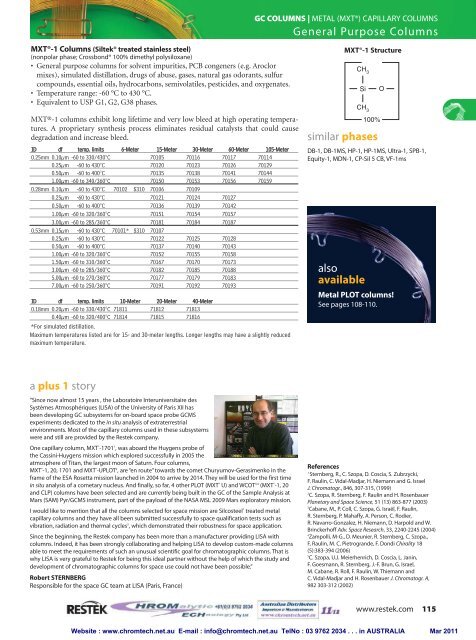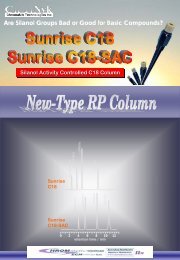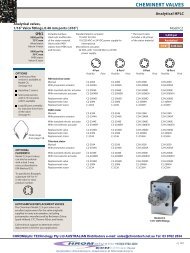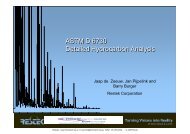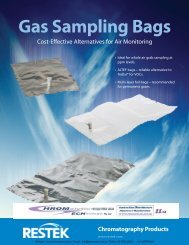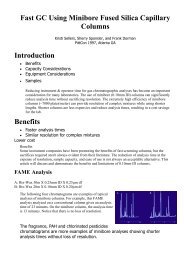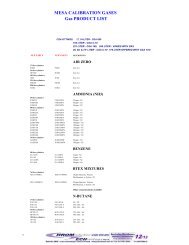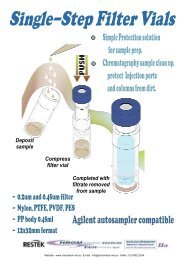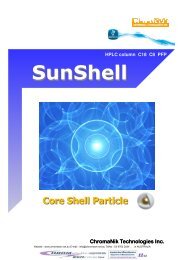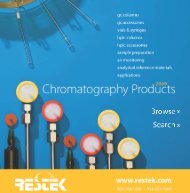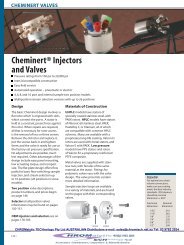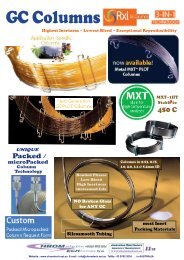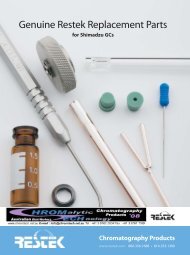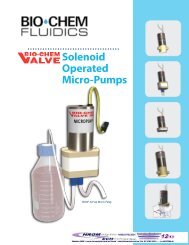gc columns
gc columns
gc columns
- No tags were found...
Create successful ePaper yourself
Turn your PDF publications into a flip-book with our unique Google optimized e-Paper software.
GC COLUMNS | METAL (MXT®) CAPILLARY COLUMNSGeneral Purpose ColumnsMXT®-1 Columns (Siltek® treated stainless steel)(nonpolar phase; Crossbond® 100% dimethyl polysiloxane)• General purpose <strong>columns</strong> for solvent impurities, PCB congeners (e.g. Aroclormixes), simulated distillation, drugs of abuse, gases, natural gas odorants, sulfurcompounds, essential oils, hydrocarbons, semivolatiles, pesticides, and oxygenates.• Temperature range: -60 °C to 430 °C.• Equivalent to USP G1, G2, G38 phases.MXT®-1 <strong>columns</strong> exhibit long lifetime and very low bleed at high operating temperatures.A proprietary synthesis process eliminates residual catalysts that could causedegradation and increase bleed.ID df temp. limits 6-Meter 15-Meter 30-Meter 60-Meter 105-Meter0.25mm 0.10µm -60 to 330/430°C 70105 70116 70117 701140.25µm -60 to 430°C 70120 70123 70126 701290.50µm -60 to 400°C 70135 70138 70141 701441.00µm -60 to 340/360°C 70150 70153 70156 701590.28mm 0.10µm -60 to 430°C 70102 $310 70106 701090.25µm -60 to 430°C 70121 70124 701270.50µm -60 to 400°C 70136 70139 701421.00µm -60 to 320/360°C 70151 70154 701573.00µm -60 to 285/360°C 70181 70184 701870.53mm 0.15µm -60 to 430°C 70101* $310 701070.25µm -60 to 430°C 70122 70125 701280.50µm -60 to 400°C 70137 70140 701431.00µm -60 to 320/360°C 70152 70155 701581.50µm -60 to 310/360°C 70167 70170 701733.00µm -60 to 285/360°C 70182 70185 701885.00µm -60 to 270/360°C 70177 70179 701837.00µm -60 to 250/360°C 70191 70192 70193ID df temp. limits 10-Meter 20-Meter 40-Meter0.18mm 0.20µm -60 to 330/430°C 71811 71812 718130.40µm -60 to 320/400°C 71814 71815 71816*For simulated distillation.Maximum temperatures listed are for 15- and 30-meter lengths. Longer lengths may have a slightly reducedmaximum temperature.MXT®-1 StructureCH 3SiCH 3100%similar phasesDB-1, DB-1MS, HP-1, HP-1MS, Ultra-1, SPB-1,Equity-1, MDN-1, CP-Sil 5 CB, VF-1msalsoavailableOMetal PLOT <strong>columns</strong>!See pages 108-110.a plus 1 story“Since now almost 15 years , the Laboratoire Interuniversitaire desSystèmes Atmosphériques (LISA) of the University of Paris XII hasbeen developing GC subsystems for on-board space probe GCMSexperiments dedicated to the in situ analysis of extraterrestrialenvironments. Most of the capillary <strong>columns</strong> used in these subsystemswere and still are provided by the Restek company.One capillary column, MXT ® -1701 1 , was aboard the Huygens probe ofthe Cassini-Huygens mission which explored successfully in 2005 theatmosphere of Titan, the largest moon of Saturn. Four <strong>columns</strong>,MXT ® -1, 20, 1701 and MXT ® -UPLOT 2 , are “en route” towards the comet Churyumov-Gerasimenko in theframe of the ESA Rosetta mission launched in 2004 to arrive by 2014. They will be used for the first timein situ analysis of a cometary nucleus. And finally, so far, 4 other PLOT (MXT ® U) and WCOT 3,4 (MXT ® -1, 20and CLP) <strong>columns</strong> have been selected and are currently being built in the GC of the Sample Analysis atMars (SAM) Pyr/GCMS instrument, part of the payload of the NASA MSL 2009 Mars exploratory mission.I would like to mention that all the <strong>columns</strong> selected for space mission are Silcosteel ® treated metalcapillary <strong>columns</strong> and they have all been submitted successfully to space qualification tests such asvibration, radiation and thermal cycles 5 , which demonstrated their robustness for space application.Since the beginning, the Restek company has been more than a manufacturer providing LISA with<strong>columns</strong>. Indeed, it has been strongly collaborating and helping LISA to develop custom-made <strong>columns</strong>able to meet the requirements of such an unusual scientific goal for chromatographic <strong>columns</strong>. That iswhy LISA is very grateful to Restek for being this ideal partner without the help of which the study anddevelopment of chromatographic <strong>columns</strong> for space use could not have been possible.”Robert STERNBERGResponsible for the space GC team at LISA (Paris, France)References1Sternberg, R., C. Szopa, D. Coscia, S. Zubrzycki,F. Raulin, C. Vidal-Madjar, H. Niemann and G. IsraelJ. Chromatogr., 846, 307-315, (1999)2C. Szopa, R. Sternberg, F. Raulin and H. RosenbauerPlanetary and Space Science, 51 (13) 863-877 (2003)3Cabane, M., P. Coll, C. Szopa, G. Israël, F. Raulin,R. Sternberg, P. Mahaffy, A. Person, C. Rodier,R. Navarro-Gonzalez, H. Niemann, D. Harpold and W.Brinckerhoff Adv. Space Research, 33, 2240-2245 (2004)4Zampolli, M-G., D. Meunier, R. Sternberg, C. Szopa.,F, Raulin, M. C. Pietrogrande, F. Dondi Chirality 18(5):383-394 (2006)5C. Szopa, U.J. Meierhenrich, D. Coscia, L. Janin,F. Goesmann, R. Sternberg, J.-F. Brun, G. Israel,M. Cabane, R. Roll, F. Raulin, W. Thiemann andC. Vidal-Madjar and H. Rosenbauer J. Chromatogr. A,982 303-312 (2002)www.restek.com 115Website : www.chromtech.net.au E-mail : info@chromtech.net.au TelNo : 03 9762 2034 . . . in AUSTRALIA Mar 2011


